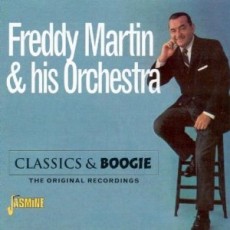
Daily Dose Of Jazz…
Freddy Martin was born Frederick Alfred Martin on December 9, 1906 in Cleveland, Ohio. Raised largely in an orphanage and with various relatives, he started out playing drums, then switched to C-melody saxophone and later the tenor saxophone that he would come to be identified with. He led his own band in high school, played in several local bands and took that money to enroll in Ohio State University.
After working on a ship’s band, Martin joined the Mason-Dixon band, then joined Arnold Johnson and then Jack Albin, with whom he would make his first recording with the “Hotel Pennsylvania Music” for Columbia’s Harmony, Velvet Tone, and Clarion 50 cent labels in 1930. However it was while filling in for Guy Lombardo one night that kick started his career. It was in 1931 at the Bossert Marine Room in Brooklyn, New York that Freddy pioneered the “Tenor Band” style that swept the sweet-music industry. With his own tenor sax as melodic lead, Martin fronted an all-tenor sax section with just two brasses and a violin trio plus rhythm.
The Martin band recorded first for Columbia, Brunswick and RCA’s Bluebird and Victor, backed singers, played hotels and became a staple on NBC’s Maybelline Penthouse Serenade. His adaptation of a Tchaikovsky tune released as Tonight We Love became his biggest hit.
Freddy Martin was nicknamed “Mr. Silvertone” by saxophonist Johnny Hodges and Chu Berry has named him his favorite saxophonist. He used the banner “Music In The Martin Manner.” Having a good ear for singers at one time or another, Martin employed Helen Ward, Stuart Wade, Merv Griffin, Buddy Clark as well as pianists Sid Appleman and Terry Shand, violinist Eddie Stone and many others.
Martin’s popularity as a bandleader led him to Hollywood in the 1940s where he and his band appeared in a handful of films, in the 1950s and 1960s he continued to perform on the radio, appear on television, be the musical director for Elvis Presley’s first Vegas appearance, and continue his hotel gigs. He would continue to lead his band until the early 80s, although by then, he was semi-retired. Bandleader and tenor saxophonist Freddy Martin passed away on September 30, 1983, in a Newport Beach hospital after a lingering illness. He was 76 years old.
More Posts: bandleader,saxophone
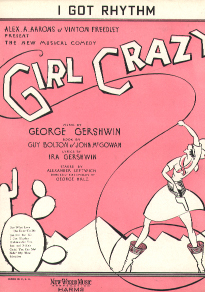
From Broadway To 52nd Street
Girl Crazy opened on October 14, 1930 at the Alvin Theatre with a run of 272 performances starring Ethel Merman and Ginger Rogers singing music composed by the Gershwin Brothers. Two songs emerged from this musical to become jazz classics – Embraceable You and I Got Rhythm.
The Story: A tale where Danny Churchill, in an attempt to flee nightclubs, gambling casinos and women, hires a NY taxi driver to take him to Custerville, Arizona. There he hopes to rest on a dude ranch. Before long he has transformed the ranch into a club with gambling rooms and bevies of girls. He woos and wins the heart of one of the girls, Ginger, who is the daughter of the local saloonkeeper.
Broadway History:Though the Depression was in full swing, stars were still being made as musicals and revues continued to emerge on Broadway. From 1931 – 42 this decade made stars of Ray Bolger and Bert Lahr, who went on to fame as the Scarecrow and Cowardly Lion in The Wizard Of Oz; the double act of Gaxton & Moore, who were part of the comic backbone of vaudeville, got their individual starts on Broadway when Gaxton, having mastered the character of a loveable, oblivious bumbler resembling Elmer Fudd with a Porky Pig personality, performed in George M. Cohan’s Forty-Five Minutes From Broadway in 1906, and the much younger Moore was the romantic lead in Rodgers and Hart’s A Connecticut Yankee in 1927. They were paired in Gershwin’s “Of Thee I Sing” and continued their successful partnership well into the ‘40s. The tradition of the double act was later upheld by the likes of Abbott & Costello, Lewis & Martin and Burns & Allen.
Sponsored By
www.whatissuitetabu.com
More Posts: broadway
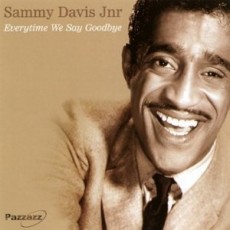
Daily Dose Of Jazz…
Sammy Davis Jr. was born Samuel George Davis, Jr. on December 8, 1925 to Cuban American parents in New York City. Starting as a child vaudevillian at age three, he toured for years nationally with the Will Masten Trio, and after military service, returned to the trio. He became an overnight sensation following a nightclub performance at Ciro’s in 1951 and with a trio became a recording artist.
As his father and uncle aged, Davis broke out to achieve success on his own and he released several albums that led to being hired to sing the title track for the Universal Pictures film “Six Bridges to Cross” in 1954. He amassed a catalogue of several dozen recordings for Decca, Reprise, Verve, Motown, MGM and 20th Century, consistently kept alive the Great American Songbook from Broadway accompanied by orchestras and big bands and had two #1 hits – “I Gotta Be Me” and The Candy Man.
Sammy starred in four Broadway musicals from 1956 to 1978 in Mr. Wonderful, Golden Boy, Sammy and Stop The World I Want To Get Off. His film career spanned nearly six decades with important roles and appearances in A Man Called Adam, Porgy & Bess, Anna Lucasta, Sweet Charity, Cannonball Run, Moon Over Parador and Tap. As a charter member of the Rat Pack he did several movies with them beginning with Oceans 11.
Not to let television escape his grasp in 1966 had his own variety show, The Sammy Davis Jr. Show, would appear on Archie Bunker, I Dream of Jeannie, The Rifleman, Charlie’s Angels, One Life To Live, General Hospital and the Cosby Show to name a few.
With his career slowing in the late sixties, by 1972 he was a star in Las Vegas earning him the nickname Mister Show Business. In 1987 Sammy toured internationally with Frank Sinatra, Dean Martin and Liza Minelli. He was awarded NAACP’s Spingarn Medal, won a Golden Globe and an Emmy, two-time recipient of the Kennedy Center Honors, has a star on the Hollywood Walk of Fame, was inducted into the Grammy Hall of Fame and posthumously awarded the Grammy Lifetime Achievement Awards.
Singer, tap dancer, impersonator and musician Sammy Davis Jr. passed away in Beverly Hills, California on May 16, 1990, of complications from throat cancer. On May 18, 1990, two days after Davis’ death, the neon lights of the Las Vegas Strip were darkened for ten minutes, as a tribute to him.
More Posts: vocal
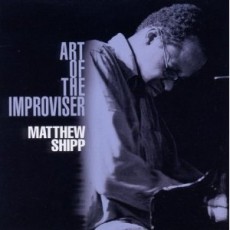
Daily Dose Of Jazz…
Matthew Shipp was born December 7, 1960 in Wilmington, Delaware and began playing piano at six years old. Strongly attracted to jazz, he also played in rock groups while in high school, and then attended the University of Delaware for one year, then the New England Conservatory of Music, where he studied with saxophonist/composer Joe Marini.
Shipp has been very active since the early 1990s initially becoming most active in free jazz but branched out to explore music that touches on contemporary classical, hip hop and electronica. He has appeared on more than three dozens of albums as a leader, sideman or producer.
Matthew has long been a member of saxophonist David S. Ware’s quartet, has recorded or performed with William Parker, DJ Spooky, Joe Morris, Daniel Carter and Roscoe Mitchell among others.
Pianist Matthew Shipp continuously improves his repertoire from touring the world, writing new compositions and currently collaborating with multi-media artist Barbara Januszkiewicz, exploring new territory through an avant-garde film called “The Composer”.
More Posts: piano
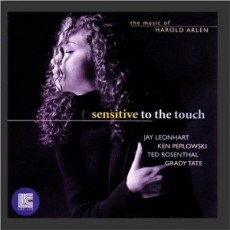
Daily Dose Of Jazz…
Jay Leonhart was born December 6, 1940 in Baltimore, Maryland and grew up in a musical family where everyone played the piano. By the age of seven, Jay and his older brother Bill were playing banjos and guitars and mandolins and basses. They played country music, jazz and anything with a beat. In their early teens, Jay and Bill were television stars in Baltimore and were touring the country performing on their banjos.
When Jay was fourteen he started playing the bass in The Pier Five Dixieland Jazz Band in Baltimore. After studying at The Peabody Institute he attended the Berklee College of Music and The Advanced School of Contemporary Music in Toronto before leaving school to start touring with the traveling big bands of the late 1950s and early 1960s.
By age 21 Leonhart moved to New York City to start his career and eventually began playing for many of the great jazz musicians, big bands, and singers like Thad Jones, Mel Lewis, Lou Marini, Tony Bennett, Marian McPartland and Jim Hall. He played lots of funky road gigs with big bands, small bands and singers and visited many little jazz joints around the world.
Jay became a very busy studio musician in New York City, visiting every musical genre from James Taylor to Ozzy Osborne to Queen Latifah, has recorded fifteen solo albums, performs a one-man show, regularly plays with Wycliffe Gordon in a duo, was named The Most Valuable Bassist in the recording industry three times by the National Academy of Arts and Sciences and continues to record, perform and tour worldwide.
More Posts: bass






